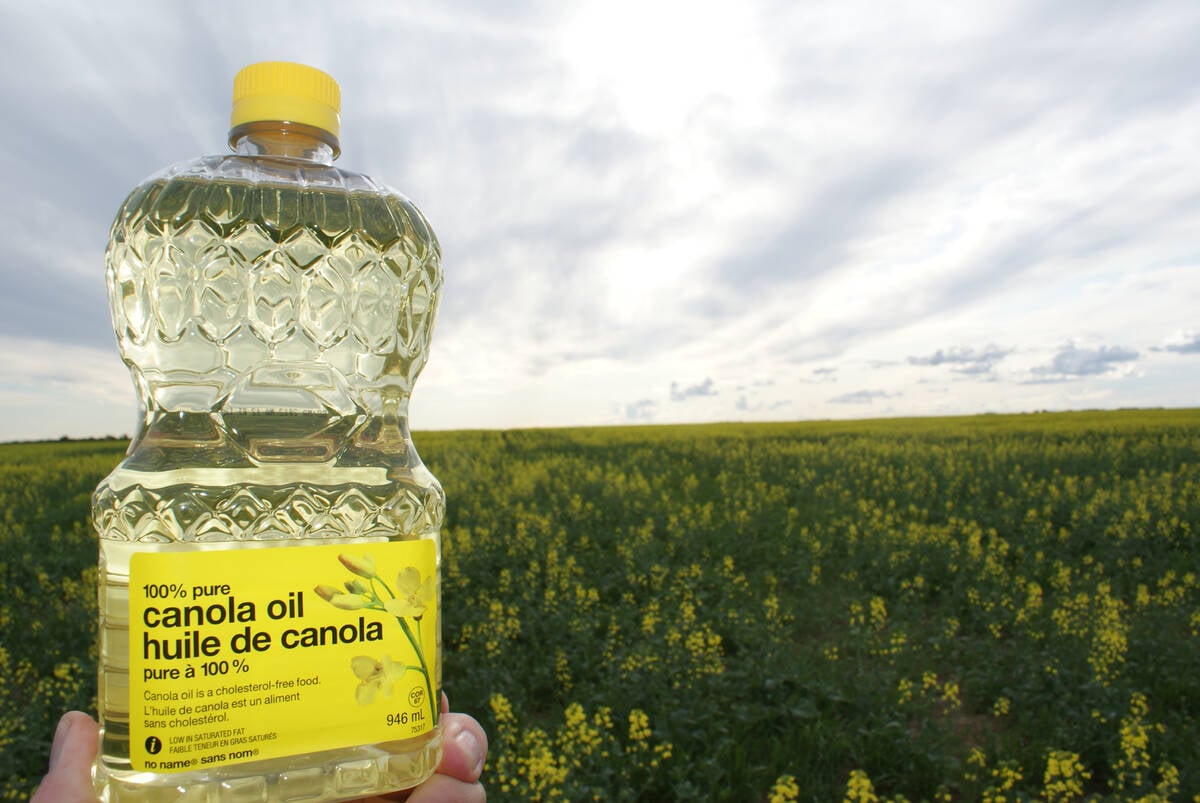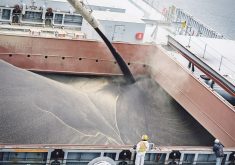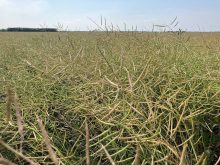There is no doubt the next slate of American farm subsidies will have a big impact on the prices and incomes of Canadian farms from 2002 onward.
“What was it Pierre Trudeau said?” quipped Alexandra Lamont, policy analyst at the Canadian Wheat Board, referring to his
famous analogy.
“Living next to you is in some ways like sleeping with an
elephant,” the former prime
minister said in 1969.
“No matter how friendly and even-tempered is the beast, if I can call it that, one is affected by every twitch and grunt.”
Read Also

Rising vegetable oil demand may offset bad biofuel news
Global biodiesel/renewable diesel production is expected to decline for the first time in a decade. Bad timing for a canola industry looking for new markets.
Canadian economist Colin Carter said he thinks Canadian farmers should keep a close eye on the farm bill elephant.
“I think it’s of critical importance to prairie agriculture given that the United States is a large competitor and a large market for Canadian farm products,” said Carter, who teaches at the
University of California, Davis.
“I guess my fear is, it’ll just be more of the same.”
Statcom Ltd. analyst Randy Strychar agreed.
“In my opinion, no matter how you slice it, dice it, it’s going to be a problem down the road,” he said.
Since there’s nothing Canadian farmers can do to influence the
debate, it’s best not to spend too much time thinking about it, said Fred Oleson, chief of market analysis with Agriculture Canada.
Bearing this in mind, here is a look at some of the current thoughts about what the 2002 farm bill could mean for Canadian producers.
More direct payments
Farm groups want to continue the flat “transition” payments (also known as “production flexibility contracts”) that have averaged $5.5 billion (US) during the past six years.
Originally designed to compensate farmers for losing the price supports of the old system of farm programs, farmers like the payments because they are reliable and help secure operating loans from bankers.
Explained Wayne Hammon of the National Association of Wheat Growers: “We’re not transitioning to anything anymore. We want to keep them.”
Changes:
Expect a new name, such as “food security payment” suggested by NAWG.
Oilseed producers haven’t been getting the payments. Conventional wisdom suggests they’ll be eligible next time, at an annual cost of $500 million to $2 billion.
Farm groups also want the $40,000 cap on payments removed.
Impact:
These payments don’t affect farmers’ planting decisions. In fact, they don’t have to plant anything to receive them.
But economists argue these types of payments can have a “wealth effect,” and indirectly encourage farmers to plant more because they tend to spend more on land and equipment.
Others say these payments are directly absorbed into land values, making U.S. farmers less competitive. And some note being wealthier doesn’t force U.S. farmers to innovate as much as Canadian producers.
“You have the ability to diversify but the pressure to diversify is not going to be as intense,” said Lamont.
More marketing loans
This cash flow tool became a safety net when prices fell. It held farmers’ incomes above average production costs and fueled expansion, especially in oilseeds.
“Without that, we would have been cooked the past little while,” said Hammon.
Added lobbyist John Gordley: “The marketing loan program has become so popular among growers, it’s going to be very difficult to dispense with it.”
Changes:
Policy makers accept that lucrative oilseed marketing loans skewed farmers’ planting decisions.
Farm groups want them to be “rebalanced” up to the oilseed level (see graphic).
They also want the $75,000 cap removed.
Impact:
This program masks market signals. Farmers plant more even when prices are poor, adding to stocks and further depressing
markets.
Rebalancing loans might take some of the pressure off oilseed markets, say Canadian analysts.
But it will encourage more corn production, putting more pressure on cereal and feed prices. That’s why U.S. livestock groups are pushing for the move.
It’s good news for Canadian livestock producers, but bad news for grain producers.
New countercyclical program
This program will kick in when incomes fall. It will take the place of emergency payments delivered by Congress.
One proposal suggests farmers get a payment when aggregate income from a basket of crops falls below a certain percentage of historical income, similar to Canada’s disaster program.
But commodity groups are pushing for the program to be broken down by crop and by state, similar to Canada’s old Gross Revenue Insurance Plan. Oilseed growers want to use the bumper income years of 1993 to 1997 as the reference years.
Cost estimates range from nothing in years of high prices to $6 billion in low-price years.
Congress may have problems designing something that fits within World Trade Organization limits on trade-distorting “amber box” programs.
Impact:
Analysts say the devil will be in the details.
If the program is broken down crop by crop, then it could influence planting and cause market distortions, similar to the marketing loan program.
Larry Martin questions why farmers would ever reduce production with this kind of program. “It’s going to be awful,” he said. “If you’re talking about a cheap food policy, that will do it.”
Risk management programs
New subsidies for crop insurance and revenue will likely continue. The U.S. Department
of Agriculture estimates these programs add about 900,000
acres to total production.
Changes:
Farmers will be able to deposit up to 10 percent of their income into tax-deferred savings accounts for withdrawal in low-income years, similar to Canada’s Net Income Stabilization Account, but without the matching government contribution.
The program will be most helpful to farms with sales of more than $250,000. Analysts say 80 percent of U.S. farmers would be limited to less than $1,000 per year in contributions.
Impact:
The new savings accounts will likely have a neutral impact on markets. But revenue insurance could continue to cause the odd distortion, such as the leap in durum acreage in 1999 when support prices were artificially high relative to poor market outlooks.
Expanded conservation set-asides
The Conservation Reserve Program pays an average of $53 per acre to keep land out of production for a decade, plus part of the costs for seeding it to forages.
Currently, more than 31 million acres are enrolled. It’s a popular program among retired and small farmers, particularly in Northern Plains states.
Changes:
Some farm groups support raising the cap to 38 or 40 million acres.
Environmental groups are pushing for as much as 64 million acres. But livestock groups and the grain trade want to keep a lid on expansion.
Impact:
Analysts say any reduction in U.S. production is positive for Canadian farmers.
The wheat board estimates
another 10 million acres in CRP could mean at least one million fewer tonnes of wheat on export markets – good news for stocks and prices.
New green payments
Democratic senator Tom Harkin of Iowa has spent three years building support for payments that reward farmers
who implement long-term environmentally friendly practices on their land, such as conservation tillage.
Payments could be in the order of $20,000 to $50,000 per year.
Farm groups support the plan, but only if it comes on top of the other programs on their lists.
Impact:
The program could have the “wealth effect” of other direct
payments.
“It sounds like a way to have your cake and eat it too,” said Lamont.
It could also have unexpected impacts, said analyst Randy Strychar. For example, oats are a competitive crop and therefore may require fewer chemicals. If growing oats helps farmers qualify for payments, the program could throw a wrench into markets, he said.
New short-term set-asides
Championed by Democratic senator Byron Dorgan of North Dakota, this program would pay farmers higher loan rates for
taking land out of production.
Commodity groups, livestock lobbyists, free traders and the grain trade have lined up to oppose it, saying it won’t help prices rise and will give away market share to Canada.
The American Farm Bureau said when the U.S. cut production by 37 million acres under old farm programs, competitors increased production by 41 million acres.
“It’s the old bride in a new dress,” sniffed economist Barry Flinchbaugh.
Impact:
Farmers will take their most marginal land out of production first, meaning the impact on supplies won’t be directly proportional. Still, “anything they can do to reduce production would be good for us,” said Martin.
Revived farmer-owned reserves
The National Farmers Union wants the government to pay farmers 30 cents per bushel per year to store up to 20 percent of their crop in times of low prices.
The group also wants the government to create its own reserves for humanitarian uses and grain-based fuels.
They believe this would raise prices by $1.5 billion per year.
Other farm groups and industry lobbyists are vehemently opposed.
Impact:
Keeping grain off markets could cause some short-term price spikes but Canadian observers say reserves hurt markets in the long run.
Reserves encourage production during low-price periods and hang over markets, keeping a lid on rallies until they finally prompt calls for export subsidies.
“Eventually, it’s going to come to roost,” said Strychar.
Return to export subsidies
Several farm groups, including the American Farm Bureau, want the government to resume its use of the Export Enhancement Program, which has laid dormant since 1996. But observers say it’s out of the question, given the U.S. neg-otiating position at WTO talks.














